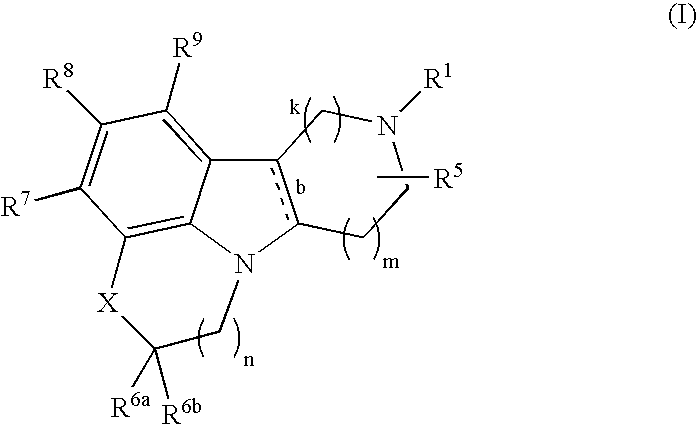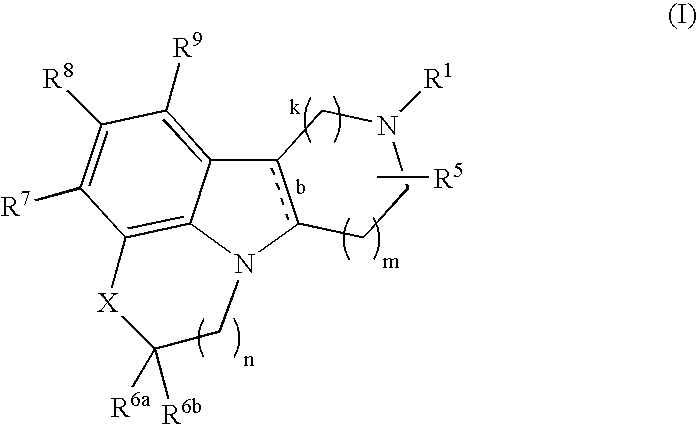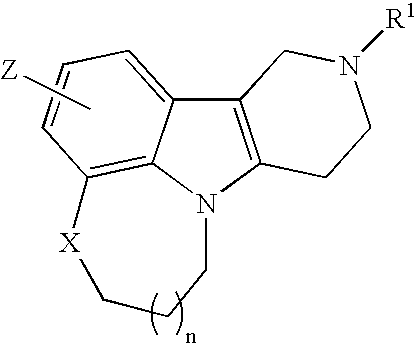Substituted heterocycle fused gamma-carbolines
a heterocyclic compound and gamma-carboline technology, applied in the field of substituted heterocyclic compound fused gamma-carbolines, can solve the problems of detracting from the efficacy of schizophrenia front line treatment, delayed onset of action, and side effects of treatmen
- Summary
- Abstract
- Description
- Claims
- Application Information
AI Technical Summary
Benefits of technology
Problems solved by technology
Method used
Image
Examples
examples
[1098]Chemical abbreviations used in the Examples are defined above. The detailed processes for preparing the compounds of Formula (I) are illustrated by the following Examples. It is, however, understood that this invention is not limited to the specific details of these examples. The Examples as set forth below are intended to demonstrate the scope of the invention but are not intended to limit the scope of the invention. Proton nuclear magnetic resonance spectra (1H NMR) were measured in chloroform-d (CDCl3) unless otherwise specified and the peaks are reported in parts per million (ppm) downfield from tetramethylsilane (TMS). The coupling patterns are reported as follows: s, singlet; d, doublet; dd, doublet of doublets; t, triplet; q, quartet; m, multiplet; bs, broad singlet; bm, broad multiplet.
example 4
ethyl 1-fluoro-6,7,9,12-tetrahydro-5H-pyrido[4,3-b][1,4]thiazepino[2,3,4-hi]indole-11(10H)-carboxylate
Step A:
[1099]p-Fluorothiophenol (5 g, 40 mmol) and β-propiolactone (2.8 g, 40 mmol) were dissolved in THF (36 mL of freshly distilled) and then placed in an ice bath. 95% sodium hydride (1 g, 42.9 mmol) was added in small portions over 1 hour. The reaction was allowed to stir at 0° C. for 2 hours, then placed in the freezer overnight. The reaction was quenched with ice chips and then acidified with concentrated hydrogen chloride until a pH of 2. The product was extracted with ethyl acetate (1×200 mL) and dichloromethane (2×200 mL), dried (sodium sulfate) and concentrated to give 3-[(4-fluorophenyl)sulfanyl]propanoic acid (7.08 g, 89%). 1H NMR (CDCl3, 300 MHz): δ 7.42–7.35 (m, 2H), 7.02 (t, 2H, J=8.6 Hz), 4.35 (t, 1H, J=6.2 Hz), 3.10 (t, 2H, J=7.3 MHz), 2.63 (t, 2H, J=7.3 Hz) ppm.
Step B:
[1100]3-[(4-fluorophenyl)sulfonyl]propanoic acid (3 g, 15 mmol) was dissolved in dichloromethane (...
example 196
8-[4-(4-fluorophenyl)-4-oxobutyl]-7,8,9,10-tetrahydro-1H-pyrido[3′,4′:4,5]pyrrolo[1,2,3-de]quinoxalin-2(3H)-one
[1106]7,8,9,10-hexahydro-2-oxo-1H-pyrido[3′,4′:4,5]-pyrrolo[1,2,3-de]quinoxalin-2(3H)-one (108 mg, 0.48 mmol) was dissolved in 1.2 mL of MEK. KI (80 mg, 0.48 mmol) and K2CO3 (193 mg, 1.40 mmol), and 4-chloro-4′-fluorobutyrophenone (124 mg, 0.62 mmol) were added. The suspension was refluxed for 48 hrs and then cooled to rt. The suspension was filtered and the residue was washed with CH2Cl2 (5 mL). The solution was concentrated in vacuo. The residue was purified by column chromatography (10% MeOH—CH2Cl2) to afford the title compound (20.1 mg, 11%) as a white amorphous solid. 1H NMR (CDCl3, 300 MHz) δ 7.90–7.94 (m, 2H), 7.00–7.05 (m, 3H), 6.84–6.89 (m, 1H), 6.42 (d, 1H, 7.0 Hz), 4.74 (s, 2H), 3.66 (s, 2H), 3.00 (t, 2H, 6.9 Hz), 2.78–2.90 (m, 2H), 2.50–2.77 (m, 4H), 1.90–2.05 (m, 2H) ppm. MS (ESI): 392.2 (base, M+H).
PUM
| Property | Measurement | Unit |
|---|---|---|
| Force | aaaaa | aaaaa |
| Force | aaaaa | aaaaa |
| Force | aaaaa | aaaaa |
Abstract
Description
Claims
Application Information
 Login to View More
Login to View More - R&D
- Intellectual Property
- Life Sciences
- Materials
- Tech Scout
- Unparalleled Data Quality
- Higher Quality Content
- 60% Fewer Hallucinations
Browse by: Latest US Patents, China's latest patents, Technical Efficacy Thesaurus, Application Domain, Technology Topic, Popular Technical Reports.
© 2025 PatSnap. All rights reserved.Legal|Privacy policy|Modern Slavery Act Transparency Statement|Sitemap|About US| Contact US: help@patsnap.com



